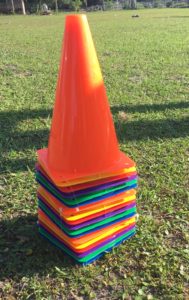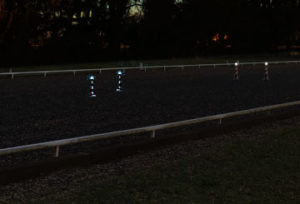(“Ten meter circle at Hatteras.”)
Ever since Major Lindgren introduced me to their use back in 1981, I’ve been big on using orange traffic cones to help riders make accurate figures and to ride through the corners. Until you can automatically do these things, a visual crutch is the best way to become aware of deviations your horse will make—usually related to a loss of balance. By catching those excursions in the first millisecond, a rider can greatly increase his horse’s attention which makes him much more reliably on the aids.
In the very old days I used to lug a stack of 18 inch high highway cones around—a major aggravation. Along the way I discovered the lightweight plastic ones next to the soccer balls at Toys R Us. I keep 20 of them nested in the back of my car.
My cone patterns make total sense to me, but they seem to unduly
challenge some of my students. One rider solved this difficulty by purchasing them in rainbow colors– “Turn down the quarter line through the green pair, leg yield right to the red pair, and left shoulder in straight ahead through the blue pair.” And so on.
This apparently was not help enough for one rider, a tenured microbiologist in her other life. For her I suggested that rather than using cones at all, she should bring her graduate students out to the lessons. I could place them appropriately in the arena, and for each exercise they would intern wave their arms and shout to her, “Over here, Dr. Harwood. Over here!”
 Another rider was visiting with her horses from Missouri. Consequently she was unfamiliar with the navigational conventions of the Atlantic seaboard. I explained to her that the lighthouses each emitted recognizable, individualized foghorn sounds, More than that, they were each painted differently so as to be identifable by ships at sea.
Another rider was visiting with her horses from Missouri. Consequently she was unfamiliar with the navigational conventions of the Atlantic seaboard. I explained to her that the lighthouses each emitted recognizable, individualized foghorn sounds, More than that, they were each painted differently so as to be identifable by ships at sea.
Before the rainbow cones came along, I offered to make up little facsimiles of prominent lighthouses to help her find her way: “Ten meter circle at Hatteras, half pass left to Tybee, counterchange to Ponce Inlet.” This would also lend itself to teaching later into the evening. As night fell, the tiny towers could illuminate and rotate like their full size versions do.
